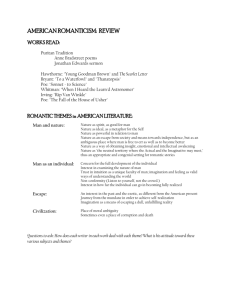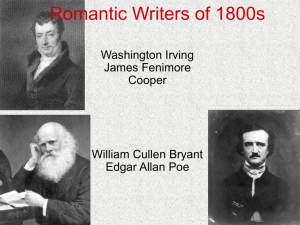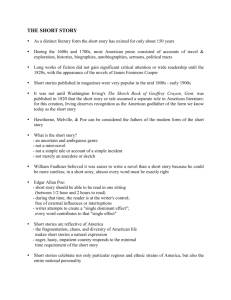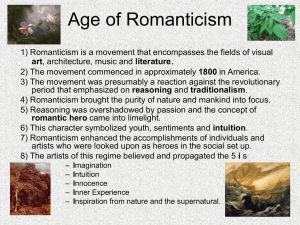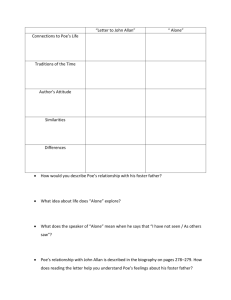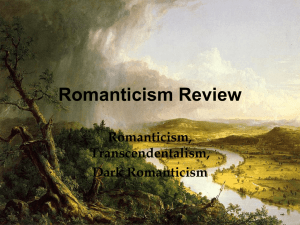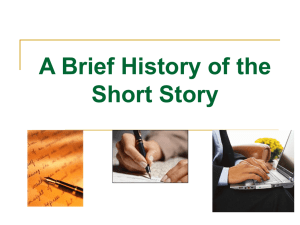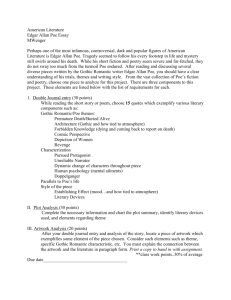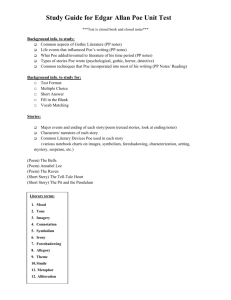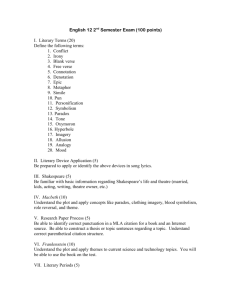Romantic Writers of 1800s
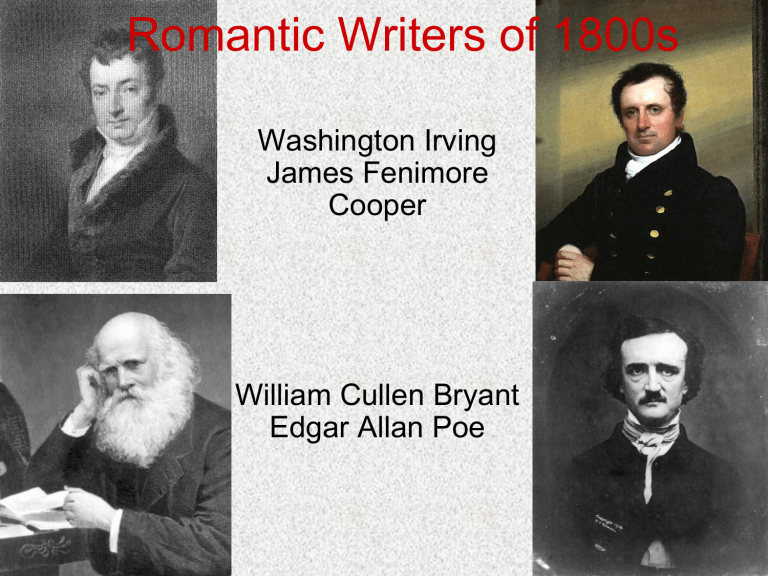
Romantic Writers of 1800s
Washington Irving
James Fenimore
Cooper
William Cullen Bryant
Edgar Allan Poe
Common Themes for Romantic
Writers
• Nature
• The Past
• The Inner World of Human Nature
Romantic Writers
• Emphasized the beauty, strangeness, and mystery of nature
• Constantly changing---as human nature changes, so do their views/perceptions of nature
Major Writers
• Washington Irving
• James Fenimore Cooper
• William Cullen Byrant
• Edgar Allan Poe
Washington Irving
• Romantic tales of folklore adapted from
European legends
• set in American landscape
• characterized by American stereotypes that reveals general truths about human nature
– Nagging wife
– Battered husband
• Old truths (stereotypes) about human nature and possibilities of American landscape (mixes history with fantasy through use of hearsay )
• Uses humorous tone (satirical at times) but conveys serious message about human values
Notable Works
• “The Legend of Sleepy Hollow”
– Link to Bartleby
• “Rip Van Winkle”
• The Sketchbook of Geoffrey Crayon, Gent.
• A History of New York…by Diedrich
Knickerbocker
Pictured: John Quidor, 1801 –81, The Headless Horseman Pursuing Ichabod Crane,
1858, oil
Rip Van Winkle, oil on canvas by John Quidor, 1829; in the Art Institute of Chicago.
“The Devil and Tom Walker”
• Common folktale about selling soul to the devil
• “Devil will get his due”
• Other Devilish Names
– black man of the forest; black miner; black woodsman; Old Scratch; Mephistopheles;
Satan; Diablo; Lucifer
Literary Analysis
Be able to provide examples or discuss each of these as they pertain to the tale.
• Characterization
– Stock, flat characters
• Tone
– Humorous
• Irony
• Style
– Mix of history and hearsay
• Message about human values
Think-Pair Share Questions
• Thoroughly summarize the entire story in just 3 sentences.
• Provide an example of human motivation affecting behavior
• What words are used to tell events are legend and NOT history?
• What historical references are used to legitimize the work?
• Tone/humor/irony
• What is his “serious” message that is reinforced by the stereotypes? (hint: see commentary)
Irving Homework
(answer in your notebook)
• Pg. 136-questions 2, 5, and 6 a and b
James Fenimore Cooper
• 1 st major American novelist
• Uses actual events in American history as settings for his novels
• his characters define their personal values by their experiences in the lawless wilderness
• Natural view of life is simple and profound
Notable Works
• Leatherstocking Tales---collection of 5 novels that chronicle life of Natty Bumppo
– The Pioneers
– The Last of the Mohicans
– The Prairie
– The Pathfinder
– The Deerslayer
• Natty Bumppo is literary hero
Literary Analysis
• Characterization
– Round, dynamic character
– Literary hero
• Conflict
– Natty as a product of two conflicting cultures
• Theme
– Nature vs. civilization
William Cullen Bryant
• Poetry reflects Romantic approach to life
• through imagination and intuition one can learn from Nature great moral and spiritual truths
• “religion of nature”---natural world is inexhaustible source of moral and spiritual lessons
• Observations of nature evoke feelings of self in oneself.
• Father of American Poetry
By living in harmony with nature,
• man will understand transience (temporary state) on earth
• accept death
• rejoice in immortality of nature
Notable Poetry
• “To A Waterfowl”
– Apostrophe---direct address to non human object
• “Thanatopsis”
– Audio version
Randy Pausch Video Homework: watch clip and complete sheet
Steve Jobs Commencement
Speech to Stanford Grads
• How are all 3 (Pausch, Bryant, and Jobs) similar?
• What traits of Romanticism do they all echo?
Poetic Devices
• Blank Verse
• Free Verse
• Caesuras
• Foot
• Meter
• Personification
• Imagery
Literary Analysis
• Lesson or truth about life in each poem
• Sentimentalism
Commentary on “Thanatopsis”
• Romantics poets were often concerned about:
– Death
– Individualism
• Since death is the final restriction upon the self and its powers, individualism (the power of the self) became an important theme in poetry.
Emphasis of the poetry
• Romantics emphasized the organic process of constant changes in nature:
Every living thing fulfills its appointed life cycle of birth, growth, decay, and death.
Sentimentalism
• An expression of feeling that is excessive for the subject and becomes an indulgence in the emotion for its own sake.
• “Thanatopsis” avoids sentimentalizing death because it neither disguises it nor dwells too much upon its sadness.
• Ashes to ashes, dust to dust mentality
Theme of “Thanatopsis”
• By living in harmony with nature, and realizing that all must come to an end, rather than fear it, one can come to accept death as a restful sleep
• If we move away from fear and bitterness about death, then our broader awareness about the “consciousness of time” (life eternal) makes it possible to accept our time on Earth and the natural completion of death.
Poe
• Romantic view of Nature and the inner self by depicting irrational characters in a grotesque reality
• Nature’s greater truth = madness
“Poe myth” vs. Poe’s Reality
• Myth = immoral behavior; fiendish; brutish
• Reality = life was dull, miserable, dreary, perhaps just unlucky
Accomplishments
• Most important American poet before Walt
Whitman
– Unreal atmosphere and musical effects influenced
French symbolist poets and on all modern poetry
• Literary critic
• Credited along with Hawthorne for giving short story it modern form
– Poe thought a short story should be short enough to be read in one sitting so as to achieve and sustain a single emotional effect
• Inventor of the detective story
Gothic Elements of Literature
• Language
– Everyday language that focuses on nature
– Repetition
• Imagery
• Mystery, horror, violence, grotesque, supernatural
“The Fall of the House of Usher”
NOTE: Usher was the name of a couple who took in Poe’s orphaned mother when she was a child; thus, Poe probably considered himself to be of the House of
Usher
Stop Animation Video
Literary Analysis
• Read Commentary
• Be able to find several examples of symbolism
• Discuss the point of view of the story and the role it plays in the story
• Discuss specific uses of imagery and the effect of that imagery in the story
Symbols
• Haunted Palace (allegory)
• Crack in the foundation of house
• Picture on the wall
• Storm
